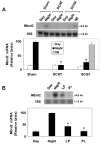Muscleblind-like 2: circadian expression in the mammalian pineal gland is controlled by an adrenergic-cAMP mechanism
- PMID: 19457059
- PMCID: PMC2766844
- DOI: 10.1111/j.1471-4159.2009.06184.x
Muscleblind-like 2: circadian expression in the mammalian pineal gland is controlled by an adrenergic-cAMP mechanism
Abstract
Muscleblind-like 2 (Mbnl2) is a zinc finger protein first identified in Drosophila. It appears to be essential for photoreceptor development and to be involved in RNA splicing. Here we report that Mbnl2 is strongly expressed in the rat pineal gland. The abundance of pineal Mbnl2 transcripts follows a marked circadian rhythm with peak levels approximately sevenfold higher at night than day levels. Mbnl2 protein exhibits a similar rhythm. In vitro studies indicate that the abundance of Mbnl2 transcripts and protein are controlled by an adrenergic/cAMP mechanism.
Figures








Similar articles
-
Developmental and diurnal dynamics of Pax4 expression in the mammalian pineal gland: nocturnal down-regulation is mediated by adrenergic-cyclic adenosine 3',5'-monophosphate signaling.Endocrinology. 2009 Feb;150(2):803-11. doi: 10.1210/en.2008-0882. Epub 2008 Sep 25. Endocrinology. 2009. PMID: 18818287 Free PMC article.
-
NGFI-B (Nurr77/Nr4a1) orphan nuclear receptor in rat pinealocytes: circadian expression involves an adrenergic-cyclic AMP mechanism.J Neurochem. 2004 Nov;91(4):946-55. doi: 10.1111/j.1471-4159.2004.02777.x. J Neurochem. 2004. PMID: 15525348
-
Phosphodiesterase 10A in the rat pineal gland: localization, daily and seasonal regulation of expression and influence on signal transduction.Neuroendocrinology. 2011;94(2):113-23. doi: 10.1159/000327138. Epub 2011 Apr 7. Neuroendocrinology. 2011. PMID: 21474921
-
Gonadal steroid modulation of neuroendocrine transduction: a transynaptic view.Cell Mol Neurobiol. 1996 Jun;16(3):357-82. doi: 10.1007/BF02088101. Cell Mol Neurobiol. 1996. PMID: 8818402 Free PMC article. Review.
-
Control of CREB phosphorylation and its role for induction of melatonin synthesis in rat pinealocytes.Biol Cell. 1997 Nov;89(8):505-11. doi: 10.1016/s0248-4900(98)80006-3. Biol Cell. 1997. PMID: 9618900 Review.
Cited by
-
Pineal function: impact of microarray analysis.Mol Cell Endocrinol. 2010 Jan 27;314(2):170-83. doi: 10.1016/j.mce.2009.07.010. Epub 2009 Jul 19. Mol Cell Endocrinol. 2010. PMID: 19622385 Free PMC article. Review.
-
Alternative Isoform Analysis of Ttc8 Expression in the Rat Pineal Gland Using a Multi-Platform Sequencing Approach Reveals Neural Regulation.PLoS One. 2016 Sep 29;11(9):e0163590. doi: 10.1371/journal.pone.0163590. eCollection 2016. PLoS One. 2016. PMID: 27684375 Free PMC article.
References
-
- Ashery-Padan R, Gruss P. Pax6 lights-up the way for eye development. Curr Opin Cell Biol. 2001;13:706–714. - PubMed
-
- Bailey MJ, Coon SL, Carter DA, Humphries A, Kim JS, Shi Q, Gaildrat P, Morin F, Ganguly S, Hogenesch JB, Weller JL, Rath MF, Moller M, Baler R, Sugden D, Rangel ZG, Munson PJ, Klein DC. Night/day changes in pineal expression of >600 genes: central role of adrenergic/cAMP signaling. J Biol Chem. 2009;284:7606–7622. - PMC - PubMed
-
- Begemann G, Paricio N, Artero R, Kiss I, Perez-Alonso M, Mlodzik M. muscleblind, a gene required for photoreceptor differentiation in Drosophila, encodes novel nuclear Cys3His-type zinc-finger-containing proteins. Development. 1997;124:4321–4331. - PubMed
-
- Charlet BN, Savkur RS, Singh G, Philips AV, Grice EA, Cooper TA. Loss of the muscle-specific chloride channel in type 1 myotonic dystrophy due to misregulated alternative splicing. Mol Cell. 2002;10:45–53. - PubMed
-
- Dansithong W, Paul S, Comai L, Reddy S. MBNL1 is the primary determinant of focus formation and aberrant insulin receptor splicing in DM1. J Biol Chem. 2005;280:5773–5780. - PubMed
Publication types
MeSH terms
Substances
Grants and funding
LinkOut - more resources
Full Text Sources
Molecular Biology Databases

